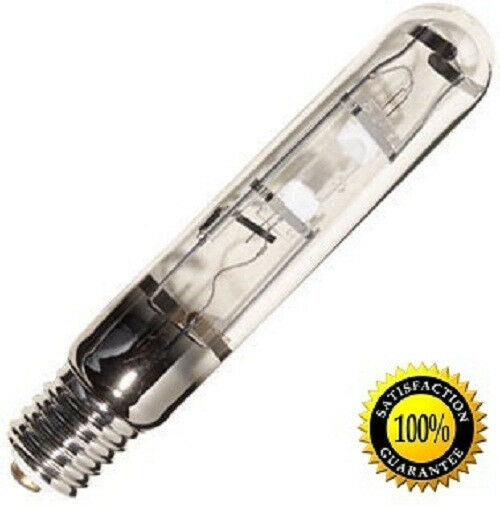The only way to see if an energy efficient update to your facility makes sense is to calculate the cost of what you already have. Your electric bill won't tell you this because the bill is a aggregate view of all of the electricity consumed from your facility, not just the lighting.
By calculating the cost of your existing fixtures, you are able to make educated decisions regarding upgrades to energy efficient lighting products.
Here are the 5 steps involved with calculating the total wattage of HID lighting fixtures because this is what we see most when visiting customers. Here are the steps you need to follow:
This article assumes that you are aware of your metal halide fixtures. But if not, here is what you need to be looking for:
The Bulb:

250 Watt Metal Halide Low-Bay

400 Watt Metal Halide High-Bay

Size, when talking about Metal Halide, the size actually refers to the wattage of the fixture. So you likely have 175 Watt MH, 250 Watt MH, 400 Watt MH or 1000 Watt MH. While the size indicates the wattage, it is not the actual wattage of the fixture ( I will explain in Step 4...)
Supply Room
Metal Halide come in many shapes and sizes. One of the easiest ways to find out the size of your fixtures is to look on the supply room shelf. You likely have a replacement bulb in there somewhere under a layer of dust.
Maintenance Staff
If you have a maintenance person, they will be able to tell you what size of Metal Halide you have. Metal Halide are typically very high maintenance and if light quality is important to what you do, you have likely order either bulb or ballast replacements in the past year.
Get A Ladder!
Climb on up there and get the number, that is if your comfortable on the ladder and you are not too high up. Be careful, make sure someone spots your ladder and be sure to let them cool down.....these babies heat up to over 900 degrees...so you won't want to be using the fixture as a balance point!
Hire A Professional Electrical Contractor
If you want to do your own calculations, but want to be exact, bring in your Electrical Contractor. They work with these types of fixtures all the time. An hour or two walking around your facility will give you a pretty good idea what you have.
(TIP: Depending on the contractor, they may not be too excited about energy efficient products. Contractors are typically a little slow to change, so if you get this sense, just let them know you want help with determining what you have. Learn more about How Contractors Are Afraid Of Energy Efficient Products in a post I did earlier this week. If your in Michigan, Tennesse or Kentucky, we can help you out!)
If you are just doing rough numbers for now, you can get a rough estimate simply by counting your fixtures. If you already have a close number, then just use that at this stage.
If you are getting ready to submit paperwork for a utility rebate, it is in your best interest to get an exact count. Most programs pay you for each fixture or total kilowatt reduction. To get the most rebate amount, get some help counting.
We have had 3 different people count in some facilities and each of us come up with a different number. You may have to count a couple of times.
The point here is you need a quantity that is close to work with to do your final calculation.
Just because your Metal Halide is 175 Watt or 400 Watt, that doesn't mean that is the actual wattage of the fixture. I guess it is easier to say 400 Watt rather than 458 Watt. Here are the ACTUAL wattages of the most common types of Metal Halide that we see.
Let's say you have (100) existing fixtures and you have determined they are 1000 Watt Metal Halide:
100 fixtures x 1,081 Watts = 108,100 Total System Watts (Assuming this is the only type of fixture you have...)
If you are considering an energy efficient upgrade, you should see a major difference in wattage consumption. In this case, one alternative technology we would look at is inductive fluorescent. We could easily replace the 1000 watt Metal Halides with 250 Watt inductive fluorescents. Here is how we would compare:
100 (New Fixtures) x 265 Watts = 26,500 Total System Watts.
Old Total System Watts - 108,100
New Total System Watts - 26,500
Wattage Reduction New System = 81,600 Watts
In this case, you would be reducing your total system wattage by over 80% which will translate into a significant amount of savings over time. This may seem unbelievable to you but it's true and we wrote an article about the project titled:Energy Efficient Lighting for Dealerships and Large Parking Lots
1. Read Some Related Blog Posts
We write extensively about different energy efficient technologies and how to calculate your energy efficient savings. Here are a few suggested articles:
2. Or...Download Our Free E-book: Business Owners Guide To Energy Efficiency
The concept of energy efficiency is often mis-understood as a gimmick or scam. We have created an e-book to help dispel that type of rhetoric. The purpose of the book is to show you how you can see significant savings with new, updated energy efficient technologies.
Download a copy to learn about the benefits of energy efficient technologies for your business.